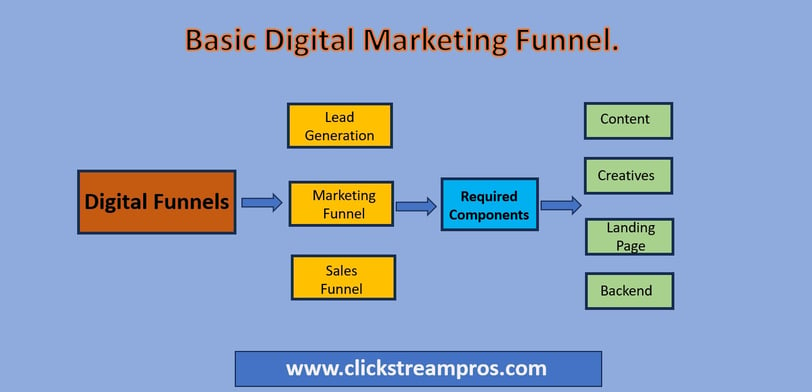Digital funnel : Types, Components & Backend.
Digital funnel : what are the Types digital funnel, required Components & Backend to create a basic digital funnel.
DIGITAL MARKETING
nikunj irani
5/25/20242 min read


Hi digital marketers! In today’s blog, we will discuss different kinds of digital funnels and their uses. Let’s start by understanding what a digital funnel is and explore the various types and their applications in digital marketing.
What is a Digital Funnel?
A digital funnel is a concept where internet users are collected as data through various methods, both simple and complex. When a user clicks on an interesting link, they enter a funnel created by a digital marketer or digital agency. This funnel has an endpoint, which leads to sales, marketing, or lead collection, achieving the end goal of the digital funnel.
Types of Digital Funnels
Digital funnels can vary in type and purpose, but they primarily serve the following functions:
Lead Generation Funnel
In a lead generation funnel, the user is encouraged to provide their data, such as phone number, name, address, location, or areas of interest. This data is collected in exchange for incentives like free e-books, discount coupons, or webinars. The collected data is then used for targeted marketing of products or services.
Marketing Funnel
A marketing funnel is used to launch a product or service. It typically includes informative blogs, videos, and short content, heavily leveraging social media platforms. This funnel aims to create a desire for the product or service in the user’s mind, leading them towards the purchase.
Sales Funnel
A sales funnel is more complex and culminates in the user making a purchase. It often combines elements of lead generation and marketing funnels, guiding the user through multiple steps until the final transaction.
Components of a Digital Funnel
Creating an effective digital funnel involves several stages:
Stage 1: Blog or Video Content
This is the initial point of contact with the user. Content should be based on your niche, relevant keywords, and search volume for better results.
How to Create a Blog:
Free Blog: Use Google products like Blogger or Google Sites.
Paid Blog: Purchase a service from hosting providers like Hostinger to create a website.
How to Create a Video Funnel: Upload creative videos on YouTube and connect them with Google Analytics (GA4) and Google Ads. Video funnels are excellent for marketing and retargeting, but not ideal for lead generation.
Stage 2: Ads and Retargeting
Use Google Ads and Meta (Facebook) pixels to target and retarget your audience. Understand your users’ demographics, location, and interests for optimal results.
Stage 3: Landing Page
Create a landing page that can be part of your blogging website or a standalone page using free services like Google Sites. This is where users take the desired action, such as providing their information or making a purchase.
Stage 4: Connecting to the Backend
Depending on the type of funnel, connect to the appropriate backend systems for data capture and management.
Lead Generation Backend:
Free CRM: Use Google Forms to collect data and store it in Google Drive.
Paid CRM: Utilize services like Zoho CRM, HubSpot, or Salesforce for advanced data management and integration with other departments.
Sales and Marketing Funnel Backend: To capture user data for sales and marketing funnels, connect your funnel with Google GA4 and Google Ads. This allows for user tracking and retargeting, which is essential for optimizing the funnel’s effectiveness.
Conclusion
We hope this guide provides you with a basic understanding of creating simple digital funnels. More complex funnels exist, and we will cover them in future blogs. We would love to hear your views on this subject. Kindly drop a comment below and subscribe to our newsletter to stay updated with the latest in the digital world.
